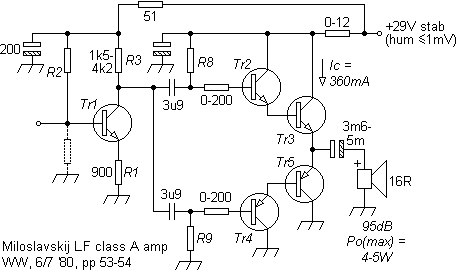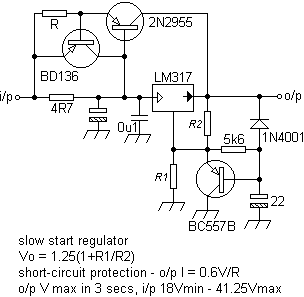
Miloslavskij class A amplifierThese designs, using single-ended and/or push-pull layouts with no overall feedback, were adopted as a basis for a 3-way power amplifier (0.5 to 10W) with passive (phase-linear) filters of 6dB/octave. Intended to drive efficient speakers within sound pressure level peaks of 100 to 108dB in rooms with volumes of 30 to 120 cubic metres, comparable to listening to symphonic music somewhere in the centre of the pits at the fortissimo, the upper frequency limit of such amplifiers may be 20MHz or more. This approach, then, recognises the fact that the maximum undistorted sound output of a speaker occurs long before the rated maximum electrical handling specification.
Non-linear distortion of the emitter follower depends primarily on the ratio between R3 and the emitter follower's input resistance, as well as on transistor linearity and the local negative feedback of this stage (0.1 to 0.2% max). The smaller the ratio, the lower the distortion. Diodes can be paralleled across the output devices to cope with adverse loads.

Input transistors - Vce(max) of 120-300V, Ic(max) 0.5-1A, fT of 20-50MHz, Pc(max) of 0.6-1.5W and a current gain of 70-140. Output transistors - Vce(max) of 300-500V, Ic(max) 2-5A, Pc(max) of 25-50W and a current gain (Darlington) of 3-5,000. Capacitors in the signal path are chosen to attenuate LF gain.

A push-pull version gives a higher output.

Output transistors - Vce(max) of 120-400V, Ic(max) 8-12A, Pc(max) of 50-120W, fT of 3-20MHz and a current gain (Darlington) of 5-10,000 (output device 60-90). For good symmetry of arms R8 ≈ R9 and βTr3 x βTr2 ≈ βTr4 x βTr5 and preferably βTr3 ≈ βTr5. To reduce instability (10 to 20%) of continuous quiescent current with temperature, R8 and R9 can be PTC thermistors. Maximum temperature of transistor junctions must not exceed 70-80°C.

A set of three amplifiers, associated filters and controls, regulator and supply could be fitted inside individual speakers thus producing an active system. Alternatively, a separate enclosure could be used. A suitable regulator might be that shown below which, with a 5V operating differential for a 29V supply, can be fed from a 25Vac primary (full-wave rectification to reduce transformer noise). Additional smoothing and decoupling can be placed near the amplifiers.

An "Audio preamplifier (RIAA) with no t.i.d." by Yuri Miloslavskij, was described in the August '79 edition of Wireless World. This used three transistors and was passively equalised (diagram here).Other class A designs; Linsley Hood, Stan Curtis' ETI System A and Jean Hiraga's 'Le Monstre'.
Contact me at paulkemble@hotmail.com
especially if you want additional content to this page
or if you find any links that don't work. Don't forget
to add the page title or URL. Take care!
Back to index, sound, tips or home.